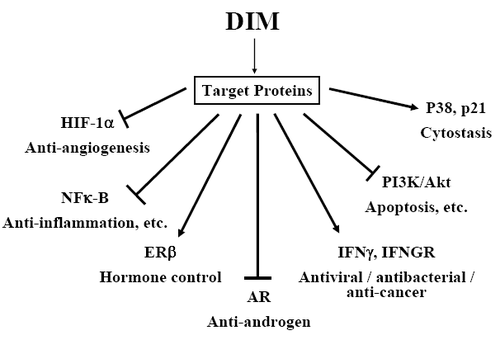- 3,3'-Diindolylmethane
-
3,3'-Diindolylmethane  3,3′-methanediylbis(1H-indole)Other names3-(1H-Indol-3-ylmethyl)-1H-indole
3,3′-methanediylbis(1H-indole)Other names3-(1H-Indol-3-ylmethyl)-1H-indole
3,3'-Methylenebis-1H-indole
DIMIdentifiers CAS number 1968-05-4 PubChem 3071 ChemSpider 2963 
ChEBI CHEBI:50182 ChEMBL CHEMBL446452 
Jmol-3D images Image 1
Image 2- C1=CC=C2C(=C1)C(=CN2)CC3=CNC4=CC=CC=C43
c1cccc2c1c(cn2)Cc4c3ccccc3nc4
- InChI=1S/C17H14N2/c1-3-7-16-14(5-1)12(10-18-16)9-13-11-19-17-8-4-2-6-15(13)17/h1-8,10-11,18-19H,9H2

Key: VFTRKSBEFQDZKX-UHFFFAOYSA-N
InChI=1/C17H14N2/c1-3-7-16-14(5-1)12(10-18-16)9-13-11-19-17-8-4-2-6-15(13)17/h1-8,10-11,18-19H,9H2
InChI=1/C17H14N2/c1-3-7-16-14(5-1)12(10-18-16)9-13-11-19-17-8-4-2-6-15(13)17/h1-8,10-11,18-19H,9H2
Key: VFTRKSBEFQDZKX-UHFFFAOYAU
Properties Molecular formula C17H14N2 Molar mass 246.31 g mol−1  (verify) (what is:
(verify) (what is:  /
/ ?)
?)
Except where noted otherwise, data are given for materials in their standard state (at 25 °C, 100 kPa)Infobox references 3,3′-Diindolylmethane or DIM is a compound derived from the digestion of indole-3-carbinol, found in cruciferous vegetables such as broccoli, Brussels sprouts, cabbage and kale.[1] The reputation of Brassica vegetables as healthy foods rests in part on the activities of diindolylmethane.[2][3]
Contents
Properties
DIM has the biological properties listed in the chart below. Because of its various potent anticancer properties, the National Cancer Institute of the United States has begun clinical trials of DIM as a therapeutic for numerous forms of cancer.[4] [5]
Uses
At the present time, DIM is used to treat recurring respiratory papillomatosis, a rare respiratory disease with tumors in the upper respiratory tracts caused by the human papilloma virus.[citation needed] In addition, DIM is in Phase III clinical trials for cervical dysplasia, a precancerous condition also caused by the human papilloma virus.[citation needed] Similarly, it has been studied and shown promising results as a immunostimulant against HPV.
See also
- Phytochemicals
References
- ^ Rakel D.. Integrative Medicine.
- ^ Gong Y. Sohn H. Xue L. Firestone GL. Bjeldanes LF (2006). "3,3'-Diindolylmethane is a novel mitochondrial H(+)-ATP synthase inhibitor that can induce p21(Cip1/Waf1) expression by induction of oxidative stress in human breast cancer cells". Cancer Research 66 (9): 4880–4887. doi:10.1158/0008-5472.CAN-05-4162. PMID 16651444.
- ^ Acharya A. Das I. Singh S. Saha T. (2010). "Chemopreventive properties of indole-3-carbinol, diindolylmethane and other constituents of cardamom against carcinogenesis". Recent patents on food, nutrition & agriculture 2 (2): 166–177. doi:10.2174/1876142911002020166.
- ^ Rogan EG (2006). "The natural chemopreventive compound indole-3-carbinol: state of the science". In Vivo 20 (2): 221–228. PMID 16634522.
- ^ Kim YS. Milner JA (2005). "Targets for indole-3-carbinol in cancer prevention". Journal of Nutritional Biochemistry 16 (2): 65–73. doi:10.1016/j.jnutbio.2004.10.007. PMID 15681163.
External links
Categories:- Indoles
- Antineoplastic drugs
- Nutrition
- C1=CC=C2C(=C1)C(=CN2)CC3=CNC4=CC=CC=C43
Wikimedia Foundation. 2010.

